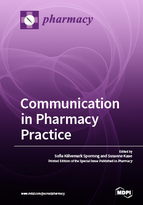Communication in Pharmacy Practice
A special issue of Pharmacy (ISSN 2226-4787).
Deadline for manuscript submissions: closed (31 October 2018) | Viewed by 96901
Special Issue Editors
Interests: professional ethics and communication; the role of pharmacists in pharmacy practice and clinical pharmacy; patient perspectives on medicine use; pharmaceutical policy
Special Issues, Collections and Topics in MDPI journals
Interests: communication between patients and health care professionals; patient-centered care; cognitive services; patient perspectives on medicine use
Special Issues, Collections and Topics in MDPI journals
Special Issue Information
Dear Colleagues,
Communication is a crucial part of pharmacy practice, in community pharmacies, as well as in other health care settings. The communicative role of pharmacists and other pharmacy staff is an important part of, e.g., dispensing, pharmaceutical care, and counselling services provided to patients. It is through high quality communication that patients’ needs can be assessed and information, education and advice given, in this way ensuring a rational use of medicine. In addition, effective inter-professional communication with other health care professions is central for health outcomes of patient treatments.
However, communication is a complex area, dealing with, not only the transmission of content, but also intrapersonal relationships, social processes, etc. Barriers and facilitators to communication are many, including psychological, socio-economic, cognitive and environmental factors. Through research in pharmacy practice communication we can help develop skills, tools and processes, to make patient encounters and other encounters as good as possible.
We invite you and your colleagues to send in articles for this Special Issue on “Communication in Pharmacy Practice”. We welcome research studies on communication in pharmacy and clinical practice, theoretical and methodological reflections, as well as reflections about tendencies and challenges in pharmacy communication.
Prof. Dr. Sofia Kälvemark Sporrong
Prof. Dr. Susanne Kaae
Guest Editors
Manuscript Submission Information
Manuscripts should be submitted online at www.mdpi.com by registering and logging in to this website. Once you are registered, click here to go to the submission form. Manuscripts can be submitted until the deadline. All submissions that pass pre-check are peer-reviewed. Accepted papers will be published continuously in the journal (as soon as accepted) and will be listed together on the special issue website. Research articles, review articles as well as short communications are invited. For planned papers, a title and short abstract (about 100 words) can be sent to the Editorial Office for announcement on this website.
Submitted manuscripts should not have been published previously, nor be under consideration for publication elsewhere (except conference proceedings papers). All manuscripts are thoroughly refereed through a single-blind peer-review process. A guide for authors and other relevant information for submission of manuscripts is available on the Instructions for Authors page. Pharmacy is an international peer-reviewed open access semimonthly journal published by MDPI.
Please visit the Instructions for Authors page before submitting a manuscript. The Article Processing Charge (APC) for publication in this open access journal is 1800 CHF (Swiss Francs). Submitted papers should be well formatted and use good English. Authors may use MDPI's English editing service prior to publication or during author revisions.
Keywords
-
Communication
-
Pharmaceutical care
-
Pharmacy practice
-
Communication theories and models
-
Communication skills







